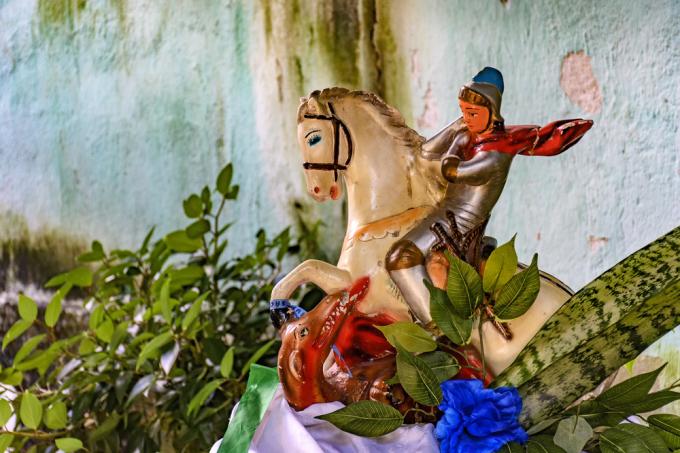O romanticism its main objective was to oppose classicism, rationalism and enlightenment, contradicting the objectivity, the image of the perfect and the realism, which characterized these movements above.
The main characteristics of romanticism are:
1. opposition to classic
For romanticism, it was important that the movement a break with the artistic models of classicism. Thus, one of the most striking features of this movement, both in literature and in the arts, was the opposition to classical models.
The best example of this characteristic is the absence of models or classic aesthetic patterns that were consecrated until then. Romanticism removed all objectivity, rationality, and exaltation of the beautiful and perfect that the classical movements represented;
Opposition to the classic model brought about a reduction in formality in writing, with more use of the so-called white (free) verses and less concern with meter and exact stanzas.
2. Manifestation of subjectivity and individuality
Compared to earlier movements, in romanticism man's thoughts and feelings were highly valued and exalted. Therefore, in artistic works, whether in literature, music or plastic arts, originality and personal opinion were indispensable.
the personal speech of the artists is an element constantly found in the works, since the freedom of expression it is an essential attribute in the romantic period. In literature, for example, the presence of the "I" and works written in the first person makes this characteristic of individuality and self-opinion clear.
These conditions were, in general, experienced by everyone, which caused a certain contradiction in the movement, as romanticism preached the individualized feeling, but in a universalized way.
3. Overvaluation of feelings
The origin of romanticism is linked to the German artistic movement called sturm und drang, which means "storm and impetus" and which was based on exaggerated and appealing feelings and emotions.
Therefore, another hallmark of romanticism is the presence of exaggerated emotions and artistic works full of sentimentality. The romantic man defended an artistic aesthetic that valued the expression of feeling much more than reason, that is, there was an overvaluation of his emotions.
In the works of romanticism the artist's feelings are clearly expressed, like pessimism, sadness, boredom, dream, anguish and love. This romantic artist's sentimentality led the second generation of the movement to be called ultra-romanticism.
Romantic literature, for example, identifies with the idealization of the loved one, who is unattainable, as something perfect that will hardly be achieved. Besides the hero man, who fights and defends his homeland, idealizing his nation as perfect.
4. Presence of pessimism and melancholy
As sentimentality and exaggerated emotions were strong characteristics of this time, the artists plastics and writers always had a melancholy and a very strong pessimism in their works romantic.
expressed a deep boredom, just like yours pain in the face of unrequited or forbidden love, in addition to an affection for death. This happens due to the artist's high idealization and constant escapism: the total escape from what is real and rational.
The English poet Lord Byron is the romantic writer best known for his pessimism. Thanks to him, the second generation of European romanticism became known as the "Byronian" or "evil of the century".
5. Exaltation of the nation and popular culture
Nationalism and the appreciation of local culture are also notable characteristics of romanticism. These two elements are easily noticed in paintings and literary works.
The love for the country came to be highlighted in the artistic production of the period. Likewise, regional folklores were also more valued by romantic artists, who were inspired by folk songs and stories.
In Brazilian romanticism, there was the appreciation of indigenous culture as the representation of the native people, very present in the first generation of romanticism in the country. The Indian had idealized characteristics and was described as a true hero. This aspect of romanticism in Brazil became known as Indianism.

iracema (1884) - José Maria de Medeiros.
The books the guaraní and iracema by José de Alencar are examples of Brazilian works with Indian characteristics.
6. social criticism
The French Revolution and its aftermath had an influence on the Romantic movement. The social consequences of the Revolution caused a deep disenchantment in society at the time and, as As a result, there was a desire to escape reality, as well as an almost utopian feeling for a better world.
All this appeal for the ideal nation and society is stamped on romantic works. The painters John Constable and Francisco Goya, for example, used to express in their works criticisms about the social problems that arose from the Industrial Revolution.
 The Disasters of War (1810-1815) - Francisco Goya.
The Disasters of War (1810-1815) - Francisco Goya.
7. exaltation to nature
Romanticism always encouraged man to appreciate and exalt nature. This is because she was observed through the sublime discourse of romanticism, which considered her as a transcendental and grandiose element and that it was part of the man himself.
In Brazil, this characteristic was predominant in the first generation, with the exaltation of the Indian and the country's forests.
read all about romanticism.
See more about the meanings of Romanticism, Naturalism, Realism and Romance.


